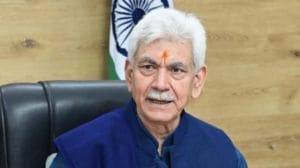Operation Sindoor signals: Three takeaways from India’s action against Pak terror
Operation Sindoor 2025 Analysis: Beyond the military objective, what purpose did Tuesday night’s action serve? How does the 2025 action differ from – and build on – the Indian actions of 2016 and 2019? What happens now?
 Operation Sindoor 2025 Analysis: Members of media film the rubble of a building damaged by Indian missile attack, in Muridke, a town in Pakistan's Punjab province, Wednesday, May 7. (Photo: AP)
Operation Sindoor 2025 Analysis: Members of media film the rubble of a building damaged by Indian missile attack, in Muridke, a town in Pakistan's Punjab province, Wednesday, May 7. (Photo: AP) Operation Sindoor 2025 Analysis: The Indian Armed Forces carried out Operation Sindoor in the early hours of Wednesday (May 7), “to deliver justice to the victims of the Pahalgam terror attack and their families”.
Nine terrorist camps in Pakistan Occupied Kashmir (PoK) and Pakistan were targeted and successfully destroyed, the government said in a press briefing.
What signals did the Indian military action send? Here are three broad takeaways from Operation Sindoor.
First, India’s response on Wednesday was not just about the terrorist attack in Pahalgam last month.
By framing Sindoor as a reply to the string of attacks since 2001, India has changed the causal chain that links Pakistan with terrorism in this country.
Rather than focus solely on Pahalgam, Wednesday’s press briefing framed Sindoor as a response to all significant acts of terrorism sponsored by Pakistan since the attack on Parliament two dozen years ago.
These attacks have been perpetrated and claimed by Pakistan-based and Pakistan-sponsored terrorist groups such as the Jaish-e-Mohammed and Lashkar-e-Taiba, which have long been designated as terrorist groups by the United Nations Security Council.
As an example of Pakistan’s failure to act legally against these terrorist outfits, India invoked the example of Sajid Mir, the Lashkar terrorist involved in the 26/11 Mumbai attacks whom Pakistan first declared dead, and later showed as having been arrested in 2022 as part of actions taken to comply with requirements imposed by the Financial Action Task Force (FATF).
These same FATF-based compulsions guided the LeT and JeM to switch from directly claiming responsibility for terror attacks in India, to raising proxies such as The Resistance Front or People’s Anti-Fascist Force etc, and to ostensibly present their actions as part of a non-religious/ non-Pakistan sponsored “Kashmiri resistance”.
Hence, having characterised Pahalgam as the latest and most heinous in a long line of attacks by these terrorist groups, Sindoor targeted the temporary and permanent infrastructure of both the JeM and LeT (and Hizbul Mujahideen) across Pakistan.
This included the JeM’s Markaz Subhan Allah (Bahawalpur), LeT’s Markaz Taiba (Muridke), and HM’s Mehmoona Joya (Sialkot).
India targeting all these sites at once undercuts Islamabad’s attempt to focus only on Pahalgam, and to disassociate groups such as TRF from Pakistan.
Second, India is, for now, focused on the terrorist infrastructure across the Line of Control/ International Border without deliberately targeting the Pakistani military.
India’s public messaging to justify its strikes deep into Pakistani territory shows a continuation of the reasoning that it adopted in 2016 and 2019 – that it will act militarily against terrorist infrastructure across the LoC and IB (sub-conventional targets), but without deliberately hitting conventional military targets.
This characteristic of India’s cross-border military action was evident in the statement of the then Foreign Secretary in February 2019: a “non-military preemptive action… specifically targeted at the JeM camp”.
Six years later, on Wednesday, the Ministry of Defence press release asserted that “no Pakistani military facilities have been targeted”.
The implication: India continues to make a distinction between terrorist infrastructure and Pakistan military targets in order to preserve some element of escalation control.
That said, however, the scale of India’s response has changed dramatically.
In 2016, the Indian surgical strikes hit terror camps across the LoC in PoK. In 2019, India struck camps in undisputed Pakistan across the LoC (Jabba Top, Balakot).
And in Op Sindoor, it struck targets deep inside Pakistan, including those across the International Border, along with targets across the LoC.
Third, while striking Pakistan, India has signalled that it does not seek full-scale war. But what happens now remains up in the air.
India has described Sindoor as “focused, measured and non-escalatory in nature”, signalling to Pakistan and the international community that it does not seek full-scale conventional war.
However, the strikes have decisively punctured Pakistan’s deterrence against India, and the credibility of the threats that it delivered to India between April 23 and May 6.
Any action by Pakistan now will be loaded with further escalatory potential, and would open the door for India to target Pakistan Army infrastructure, should it cross India’s threshold of tolerance.
Bashir Ali Abbas is a Senior Research Associate at the Council for Strategic and Defense Research, New Delhi






- 01
- 02
- 03
- 04
- 05
































